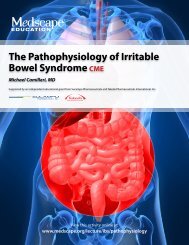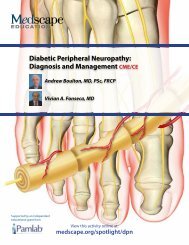FAX Order Form for ELIDEL® (pimecrolimus) Cream 1 ... - Medscape
FAX Order Form for ELIDEL® (pimecrolimus) Cream 1 ... - Medscape
FAX Order Form for ELIDEL® (pimecrolimus) Cream 1 ... - Medscape
- No tags were found...
Create successful ePaper yourself
Turn your PDF publications into a flip-book with our unique Google optimized e-Paper software.
Elidel ® (<strong>pimecrolimus</strong>) <strong>Cream</strong> 1%Prolonged systemic use of calcineurin inhibitors <strong>for</strong> sustained immunosuppression in animal studies andtransplant patients following systemic administration has been associated with an increased risk of infections,lymphomas, and skin malignancies. These risks are associated with the intensity and duration ofimmunosuppression.Based on this in<strong>for</strong>mation and the mechanism of action, there is a concern about a potential risk with theuse of topical calcineurin inhibitors, including ELIDEL <strong>Cream</strong>. While a causal relationship has not beenestablished, rare cases of skin malignancy and lymphoma have been reported in patients treated with topicalcalcineurin inhibitors, including ELIDEL <strong>Cream</strong>. There<strong>for</strong>e:• ELIDEL <strong>Cream</strong> should not be used in immunocompromised adults and children.• If signs and symptoms of atopic dermatitis do not improve within 6 weeks, patients should bere-examined by their healthcare provider and their diagnosis be confirmed (see PRECAUTIONS).• The safety of ELIDEL <strong>Cream</strong> has not been established beyond one year of non-continuous use.(See CLINICAL PHARMACOLOGY, WARNINGS, boxed WARNING, PRECAUTIONS, INDICATIONS ANDUSAGE, and DOSAGE AND ADMINISTRATION.)PRECAUTIONSGeneralThe use of ELIDEL <strong>Cream</strong> should be avoided on malignant or pre-malignant skin conditions. Malignant orpre-malignant skin conditions, such as cutaneous T-cell lymphoma (CTCL), can present as dermatitis.ELIDEL <strong>Cream</strong> should not be used in patients with Netherton’s Syndrome or other skin diseases wherethere is the potential <strong>for</strong> increased systemic absorption of <strong>pimecrolimus</strong>. The safety of ELIDEL <strong>Cream</strong> hasnot been established in patients with generalized erythroderma.The use of ELIDEL <strong>Cream</strong> may cause local symptoms such as skin burning (burning sensation, stinging,soreness) or pruritus. Localized symptoms are most common during the first few days of ELIDEL <strong>Cream</strong>application and typically improve as the lesions of atopic dermatitis resolve (see ADVERSE REACTIONS).Bacterial and Viral Skin Infections: Be<strong>for</strong>e commencing treatment with ELIDEL <strong>Cream</strong>, bacterial or viralinfections at treatment sites should be resolved. Studies have not evaluated the safety and efficacy ofELIDEL <strong>Cream</strong> in the treatment of clinically infected atopic dermatitis.While patients with atopic dermatitis are predisposed to superficial skin infections including eczema herpeticum(Kaposi’s varicelli<strong>for</strong>m eruption), treatment with ELIDEL <strong>Cream</strong> may be independently associatedwith an increased risk of varicella zoster virus infection (chicken pox or shingles), herpes simplex virusinfection, or eczema herpeticum.In clinical studies, 15/1,544 (1%) cases of skin papilloma (warts) were observed in patients using ELIDEL<strong>Cream</strong>. The youngest patient was age 2 and the oldest was age 12. In cases where there is worsening ofskin papillomas or they do not respond to conventional therapy, discontinuation of ELIDEL <strong>Cream</strong> shouldbe considered until complete resolution of the warts is achieved.Patients with Lymphadenopathy: In clinical studies, 14/1,544 (0.9%) cases of lymphadenopathy werereported while using ELIDEL <strong>Cream</strong>. These cases of lymphadenopathy were usually related to infectionsand noted to resolve upon appropriate antibiotic therapy. Of these 14 cases, the majority had either a clearetiology or were known to resolve. Patients who receive ELIDEL <strong>Cream</strong> and who develop lymphadenopathyshould have the etiology of their lymphadenopathy investigated. In the absence of a clear etiology <strong>for</strong> thelymphadenopathy, or in the presence of acute infectious mononucleosis, ELIDEL <strong>Cream</strong> should be discontinued.Patients who develop lymphadenopathy should be monitored to ensure that the lymphadenopathyresolves.Sun Exposure: During the course of treatment, it is prudent <strong>for</strong> patients to minimize or avoid natural orartificial sunlight exposure, even while ELIDEL is not on the skin. The potential effects of ELIDEL <strong>Cream</strong>on skin response to ultraviolet damage are not known.Immunocompromised Patients: The safety and efficacy of ELIDEL <strong>Cream</strong> in immunocompromisedpatients have not been studied.In<strong>for</strong>mation <strong>for</strong> Patients(See Medication Guide.)Patients using ELIDEL <strong>Cream</strong> should receive the following in<strong>for</strong>mation and instructions:What is the most important in<strong>for</strong>mation a patient should know about ELIDEL <strong>Cream</strong>?The safety of using ELIDEL <strong>Cream</strong> <strong>for</strong> a long period of time is not known. A very small number of peoplewho have used ELIDEL <strong>Cream</strong> have had cancer (<strong>for</strong> example, skin or lymphoma). However, a link withELIDEL <strong>Cream</strong> use has not been shown. Because of this concern:• A patient should not use ELIDEL <strong>Cream</strong> continuously <strong>for</strong> a long time.• ELIDEL <strong>Cream</strong> should be used only on areas of skin that have eczema.• ELIDEL <strong>Cream</strong> is not <strong>for</strong> use on a child under 2 years old.How should a patient use ELIDEL <strong>Cream</strong>?• A patient should use ELIDEL <strong>Cream</strong> exactly as prescribed.• A patient should use ELIDEL <strong>Cream</strong> only on areas of skin that have eczema.• A patient should use ELIDEL <strong>Cream</strong> <strong>for</strong> short periods, and if needed, treatment may be repeated withbreaks in between.• A patient should stop ELIDEL <strong>Cream</strong> when the signs and symptoms of eczema, such as itching, rash,and redness go away, or as directed by the physician.• A patient should follow the physician’s advice if symptoms of eczema return after a treatment withELIDEL <strong>Cream</strong>.• A patient should contact the physician if:• symptoms get worse with ELIDEL <strong>Cream</strong>• the patient gets a skin infection• symptoms do not improve after 6 weeks of treatmentTo apply ELIDEL <strong>Cream</strong>:• A patient or caregiver should wash their hands be<strong>for</strong>e using ELIDEL <strong>Cream</strong>. When applying ELIDEL<strong>Cream</strong> after a bath or shower, the skin should be dry.• A patient or caregiver should apply a thin layer of ELIDEL <strong>Cream</strong> only to the affected skin areas, twice aday, as directed by the physician.• A patient or caregiver should use the smallest amount of ELIDEL <strong>Cream</strong> needed to control the signs andsymptoms of eczema.• Caregivers applying ELIDEL <strong>Cream</strong> to a patient, or a patient who is not treating the hands should washtheir hands with soap and water after applying ELIDEL <strong>Cream</strong>. This should remove any cream left on thehands.• A patient should not bathe, shower or swim right after applying ELIDEL <strong>Cream</strong>. This could wash off the cream.• A patient can use moisturizers with ELIDEL <strong>Cream</strong>. They should be sure to check with the physician firstabout the products that are right <strong>for</strong> them. Because the skin of patients with eczema can be very dry, itis important they keep up good skin care practices. If a patient uses moisturizers, he or she shouldapply them after ELIDEL <strong>Cream</strong>.What should a patient avoid while using ELIDEL <strong>Cream</strong>?• A patient should not use sun lamps, tanning beds, or get treatment with ultraviolet light therapy duringtreatment with ELIDEL <strong>Cream</strong>.• A patient should limit sun exposure during treatment with ELIDEL <strong>Cream</strong> even when the medicine is noton the skin. If a patient needs to be outdoors after applying ELIDEL <strong>Cream</strong>, the patient should wearloose fitting clothing that protects the treated area from the sun. The physician should advise the patientabout other types of protection from the sun.• A patient should not cover the skin being treated with bandages, dressings or wraps. A patient can wearnormal clothing.• A patient should not use ELIDEL <strong>Cream</strong> in the eyes. If ELIDEL <strong>Cream</strong> gets in the eyes, a patient shouldrinse them with cold water.• A patient should not swallow ELIDEL <strong>Cream</strong> and should contact the physician if they do.Drug InteractionsPotential interactions between ELIDEL and other drugs, including immunizations, have not been systematicallyevaluated. Due to low blood levels of <strong>pimecrolimus</strong> detected in some patients after topical application,systemic drug interactions are not expected, but cannot be ruled out. The concomitant administrationof known CYP3A family of inhibitors in patients with widespread and/or erythrodermic disease should bedone with caution. Some examples of such drugs are erythromycin, itraconazole, ketoconazole, fluconazole,calcium channel blockers and cimetidine.Carcinogenesis, Mutagenesis, Impairment of FertilityIn a 2-year rat dermal carcinogenicity study using ELIDEL <strong>Cream</strong>, a statistically significant increase in theincidence of follicular cell adenoma of the thyroid was noted in low, mid and high dose male animals comparedto vehicle and saline control male animals. Follicular cell adenoma of the thyroid was noted in thedermal rat carcinogenicity study at the lowest dose of 2 mg/kg/day [0.2% <strong>pimecrolimus</strong> cream; 1.5X theMaximum Recommended Human Dose (MRHD) based on AUC comparisons]. No increase in the incidenceof follicular cell adenoma of the thyroid was noted in the oral carcinogenicity study in male rats upto 10 mg/kg/day (66X MRHD based on AUC comparisons). However, oral studies may not reflect continuousexposure or the same metabolic profile as by the dermal route. In a mouse dermal carcinogenicitystudy using <strong>pimecrolimus</strong> in an ethanolic solution, no increase in incidence of neoplasms was observed inthe skin or other organs up to the highest dose of 4 mg/kg/day (0.32% <strong>pimecrolimus</strong> in ethanol) 27X MRHDbased on AUC comparisons. However, lymphoproliferative changes (including lymphoma) were noted in a13 week repeat dose dermal toxicity study conducted in mice using <strong>pimecrolimus</strong> in an ethanolic solutionat a dose of 25 mg/kg/day (47X MRHD based on AUC comparisons). No lymphoproliferative changeswere noted in this study at a dose of 10 mg/kg/day (17X MRHD based on AUC comparison). However, thelatency time to lymphoma <strong>for</strong>mation was shortened to 8 weeks after dermal administration of <strong>pimecrolimus</strong>dissolved in ethanol at a dose of 100 mg/kg/day (179-217X MRHD based on AUC comparisons).In a mouse oral (gavage) carcinogenicity study, a statistically significant increase in the incidence of lymphomawas noted in high dose male and female animals compared to vehicle control male and femaleanimals. Lymphomas were noted in the oral mouse carcinogenicity study at a dose of 45 mg/kg/day(258-340X MRHD based on AUC comparisons). No drug-related tumors were noted in the mouse oralcarcinogenicity study at a dose of 15 mg/kg/day (60-133X MRHD based on AUC comparisons). In an oral(gavage) rat carcinogenicity study, a statistically significant increase in the incidence of benign thymomawas noted in 10 mg/kg/day <strong>pimecrolimus</strong> treated male and female animals compared to vehicle controltreated male and female animals. In addition, a significant increase in the incidence of benign thymomawas noted in another oral (gavage) rat carcinogenicity study in 5 mg/kg/day <strong>pimecrolimus</strong> treated maleanimals compared to vehicle control treated male animals. No drug-related tumors were noted in the ratoral carcinogenicity study at a dose of 1 mg/kg/day male animals (1.1X MRHD based on AUC comparisons)and at a dose of 5 mg/kg/day <strong>for</strong> female animals (21X MRHD based on AUC comparisons).In a 52-week dermal photo-carcinogenicity study, the median time to onset of skin tumor <strong>for</strong>mation wasdecreased in hairless mice following chronic topical dosing with concurrent exposure to UV radiation (40weeks of treatment followed by 12 weeks of observation) with the ELIDEL <strong>Cream</strong> vehicle alone. No additionaleffect on tumor development beyond the vehicle effect was noted with the addition of the activeingredient, <strong>pimecrolimus</strong>, to the vehicle cream.A 39-week oral monkey toxicology study was conducted with <strong>pimecrolimus</strong> doses of 15, 45 and120 mg/kg/day. A dose dependent increase in expression of immunosuppressive-related lymphoproliferativedisorder (IRLD) associated with lymphocryptovirus (a monkey strain of virus related to humanEpstein Barr virus) was observed. IRLD in monkeys mirrors what has been noted in human transplantpatients after chronic systemic immunosuppressive therapy, post transplantation lymphoproliferative disease(PTLD), after treatment with chronic systemic immunosuppressive therapy. Both IRLD and PTLD canprogress to lymphoma, which is dependent on the dose and duration of systemic immunosuppressivetherapy. A dose dependent increase in opportunistic infections (a signal of systemic immunosuppression)was also noted in this monkey study. A no observed adverse effect level (NOAEL) <strong>for</strong> IRLD and opportunisticinfections was not established in this study. IRLD occurred at the lowest dose of 15 mg/kg/day <strong>for</strong>39 weeks [31X the Maximum Recommended Human Dose (MRHD) of ELIDEL <strong>Cream</strong> based on AUC comparisons]in this study. A partial recovery from IRLD was noted upon cessation of dosing in this study.A battery of in vitro genotoxicity tests, including Ames assay, mouse lymphoma L5178Y assay, and chromosomeaberration test in V79 Chinese hamster cells and an in vivo mouse micronucleus test revealed noevidence <strong>for</strong> a mutagenic or clastogenic potential <strong>for</strong> the drug.An oral fertility and embryofetal developmental study in rats revealed estrus cycle disturbances, postimplantationloss and reduction in litter size at the 45 mg/kg/day dose (38X MRHD based on AUC comparisons).No effect on fertility in female rats was noted at 10 mg/kg/day (12X MRHD based on AUC comparisons).No effect on fertility in male rats was noted at 45 mg/kg/day (23X MRHD based on AUC comparisons),which was the highest dose tested in this study.A second oral fertility and embryofetal developmental study in rats revealed reduced testicular and epididymalweights, reduced testicular sperm counts and motile sperm <strong>for</strong> males and estrus cycle disturbances,decreased corpora lutea, decreased implantations and viable fetuses <strong>for</strong> females at 45 mg/kg/daydose (123X MRHD <strong>for</strong> males and 192X MRHD <strong>for</strong> females based on AUC comparisons). No effect on fertilityin female rats was noted at 10 mg/kg/day (5X MRHD based on AUC comparisons). No effect on fertilityin male rats was noted at 2 mg/kg/day (0.7X MRHD based on AUC comparisons).PregnancyTeratogenic Effects: Pregnancy Category CThere are no adequate and well-controlled studies of topically administered <strong>pimecrolimus</strong> in pregnantwomen. The experience with ELIDEL <strong>Cream</strong> when used by pregnant women is too limited to permitassessment of the safety of its use during pregnancy.In dermal embryofetal developmental studies, no maternal or fetal toxicity was observed up to the highestpracticable doses tested, 10 mg/kg/day (1% <strong>pimecrolimus</strong> cream) in rats (0.14X MRHD based on bodysurface area) and 10 mg/kg/day (1% <strong>pimecrolimus</strong> cream) in rabbits (0.65X MRHD based on AUC comparisons).The 1% <strong>pimecrolimus</strong> cream was administered topically <strong>for</strong> 6 hours/day during the period o<strong>for</strong>ganogenesis in rats and rabbits (gestational days 6-21 in rats and gestational days 6-20 in rabbits).A second dermal embryofetal development study was conducted in rats using <strong>pimecrolimus</strong> creamapplied dermally to pregnant rats (1 g cream/kg body weight of 0.2%, 0.6% and 1.0% <strong>pimecrolimus</strong>cream) from gestation day 6 to 17 at doses of 2, 6, and 10 mg/kg/day with daily exposure of approximately22 hours. No maternal, reproductive, or embryo-fetal toxicity attributable to <strong>pimecrolimus</strong> wasnoted at 10 mg/kg/day (0.66X MRHD based on AUC comparisons), the highest dose evaluated in thisstudy. No teratogenicity was noted in this study at any dose.A combined oral fertility and embryofetal developmental study was conducted in rats and an oral embryofetaldevelopmental study was conducted in rabbits. Pimecrolimus was administered during the period of


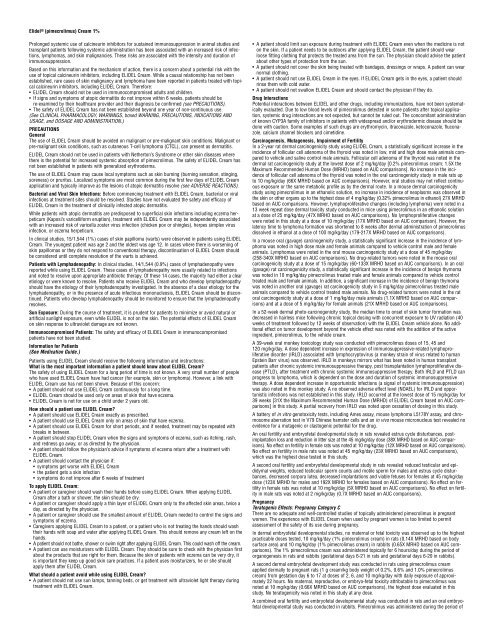
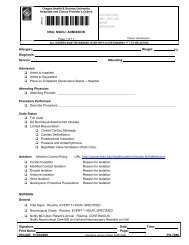


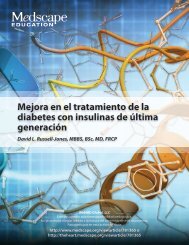
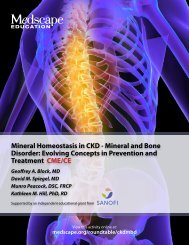
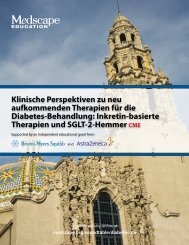


![NIH STROKE SCALE Interval: 1[ ] Baseline 2[ ] 2 hours ... - Medscape](https://img.yumpu.com/43645244/1/190x245/nih-stroke-scale-interval-1-baseline-2-2-hours-medscape.jpg?quality=85)
